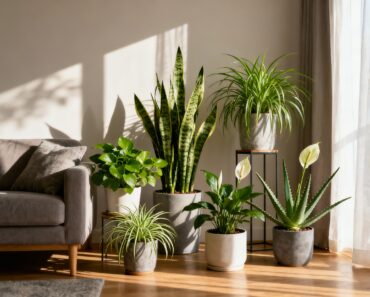Indoor plants bring life, color, and fresh energy to your home. However, like any living beings, they can experience health issues that impact their growth and appearance. Understanding common problems and how to effectively address them is essential for every plant lover, especially busy homekeepers seeking lasting greenery without constant guesswork.
This guide explores frequent indoor plant issues—ranging from watering mistakes, pests, diseases, to environmental stress—and offers straightforward solutions to help your plants thrive.
Overwatering and Underwatering
The Most Common Culprit: Many plant problems stem from improper watering.
-
Overwatering Signs: Yellowing or wilting leaves, soggy soil, foul smell from the pot, brown and soft roots (root rot).
-
Underwatering Signs: Limp, dry leaves, slow or stunted growth, brown leaf edges.
How to Fix:
-
Check soil moisture before watering by sticking your finger an inch or two below the surface.
-
Water only when soil feels dry beneath. Avoid letting plants sit in standing water; use pots with drainage holes.
-
Repot plants suffering root rot in fresh, well-draining soil.
-
Adapt watering frequency to plant type, pot size, season, and environment.
Inadequate Light
Plants have diverse light needs, and improper lighting causes leaf yellowing, leggy or elongated growth, and poor flowering.
How to Fix:
-
Research your plant’s light preferences (low, medium, or bright indirect light).
-
Move plants closer to windows or provide supplemental grow lights if natural light is insufficient.
-
Rotate plants regularly for even light exposure.
Nutrient Deficiencies
Lack of essential nutrients results in pale leaves, weak stems, or failure to flower.
How to Fix:
-
Feed your plants with an appropriate balanced fertilizer during the growing season.
-
Use water-soluble or slow-release formulas and avoid over-fertilization which harms roots.
-
Repot to replenish nutrients every 1-2 years.
Temperature and Humidity Stress
Houseplants from tropical origins may show curled, browning, or dropping leaves if exposed to dry air, cold drafts, or extreme heat.
How to Fix:
-
Maintain stable temperatures, ideally between 65-75°F (18-24°C).
-
Increase humidity by misting, grouping plants, using pebble trays, or humidifiers.
-
Keep plants away from drafty windows, heaters, or air conditioners.
Pests: Identification and Treatment
Indoor plants are susceptible to pests including aphids, spider mites, mealybugs, scale, thrips, and fungus gnats. Signs include discolored or distorted leaves, sticky residues, visible insects, or webbing.
How to Fix:
-
Isolate affected plants immediately.
-
Wash leaves with mild soapy water or use rubbing alcohol to remove pests.
-
Apply insecticidal soap, neem oil, or horticultural oils for persistent infestations.
-
Use yellow sticky traps for flying pests like fungus gnats.
-
Repot soil if larvae are present and reduce watering.
Common Diseases and Fungal Issues
Symptoms like powdery mildew, mold, blackened stems or roots indicate fungal infections usually caused by excessive moisture and poor air circulation.
How to Fix:
-
Remove affected plant parts promptly and dispose of them.
-
Improve air flow and avoid misting leaves excessively.
-
Use fungicides or natural remedies like baking soda solution.
-
Keep plants’ soil surface clean and remove debris.
Leaf and Flower Drop
Stressors like relocation, sudden environment changes, or watering issues often cause leaf or flower drop. Though alarming, this is often temporary.
How to Fix:
-
Gradually acclimate plants to new locations.
-
Maintain consistent care routines including watering and lighting.
-
Trim off dropped leaves to encourage new growth.
Stunted or Distorted Growth
Poor growth or twisted leaves may result from nutrient imbalances, pests, or inadequate light.
How to Fix:
-
Inspect closely for pests and treat accordingly.
-
Adjust feeding schedules and optimize lighting.
-
Repot if roots appear crowded or soil is depleted.
Tips for Proactive Plant Care
-
Regularly inspect plants for early signs of trouble.
-
Provide suitable pots with drainage and proper soil types.
-
Keep records of watering, feeding, and changes in environment.
-
Quarantine new plants to prevent pest introduction.
-
Clean leaves to encourage healthy photosynthesis.
Conclusion
Troubleshooting indoor plant problems can seem daunting but becomes manageable with knowledge and observation. With proper watering, lighting, pest control, and care adjustments, your plants will flourish as vibrant, refreshing additions to your home. Remember, patience and consistent attention are key to reviving struggling plants and preventing future issues.
- https://www.missouribotanicalgarden.org/gardens-gardening/your-garden/help-for-the-home-gardener/advice-tips-resources/visual-guides/problems-common-to-many-indoor-plants
- https://dennis7dees.com/common-houseplant-problems/
- https://www.rhs.org.uk/plants/types/houseplants/how-to-help-a-poorly-houseplant
- https://haltonmastergardeners.com/2024/11/23/a-guide-to-indoor-plant-pests-and-diseases/
- https://www.urbanplant.in/a/blog/category/plant-problems-solutions
- https://www.palmers.co.nz/blogs/gardening-inspiration/common-houseplant-problems
- https://phsonline.org/for-gardeners/gardeners-blog/houseplant-tips-indoor-plant-care
- https://miraclegro.com/en-us/indoor-gardening/common-indoor-plant-problems-and-how-to-fix-them.html
- https://www.reddit.com/r/plantclinic/comments/o78mnv/a_guide_to_common_houseplant_problems/



